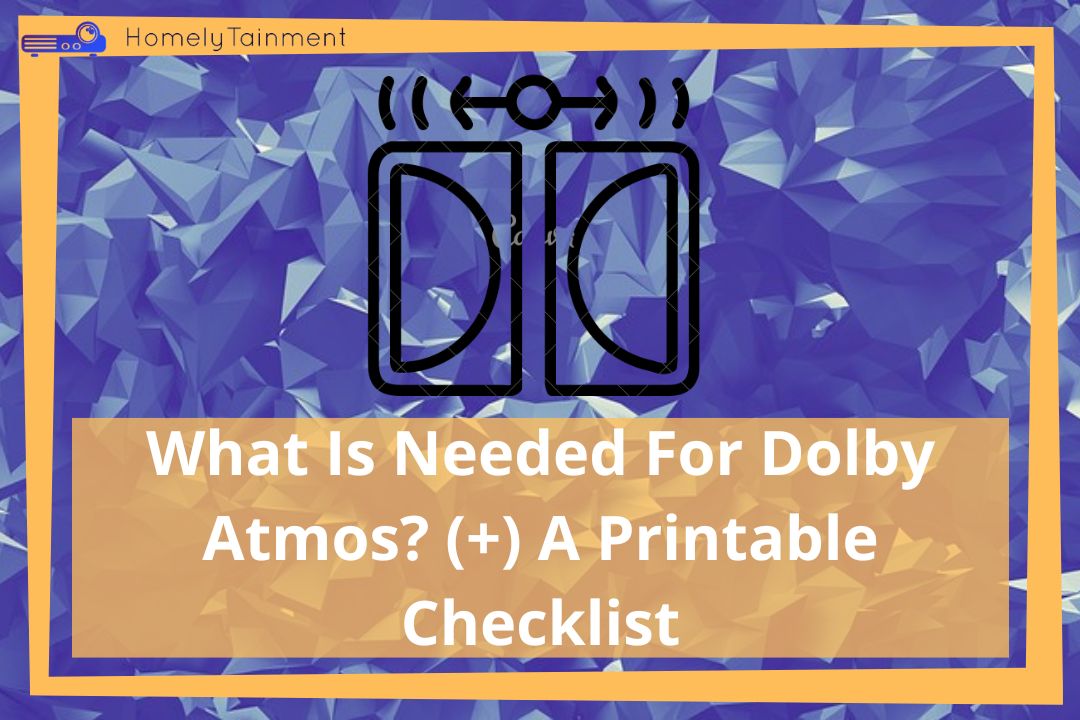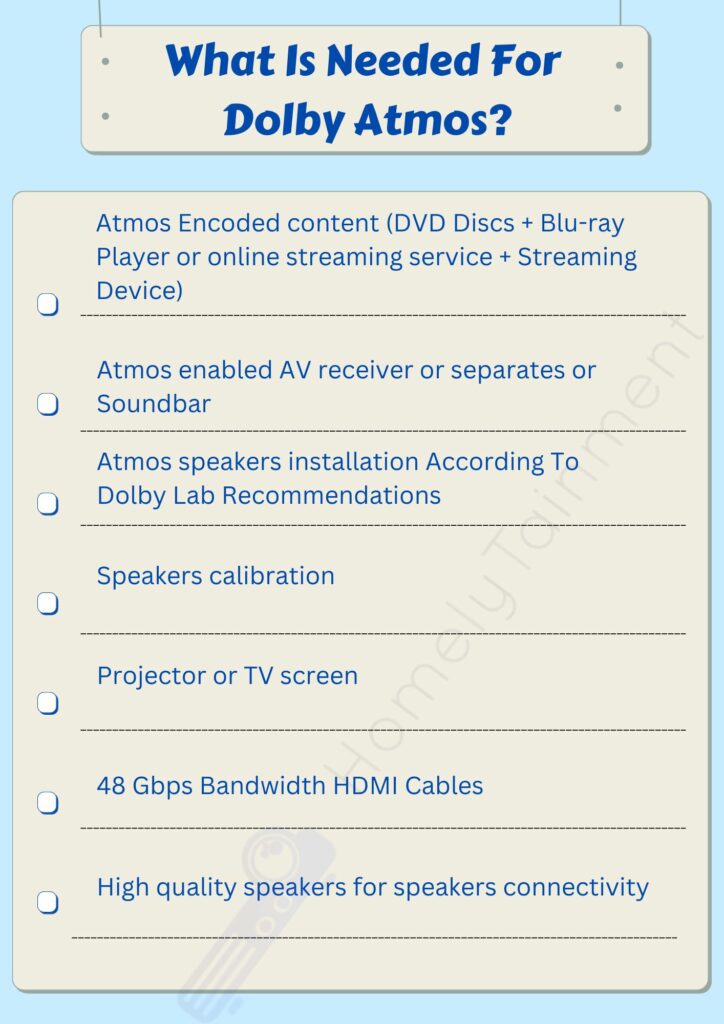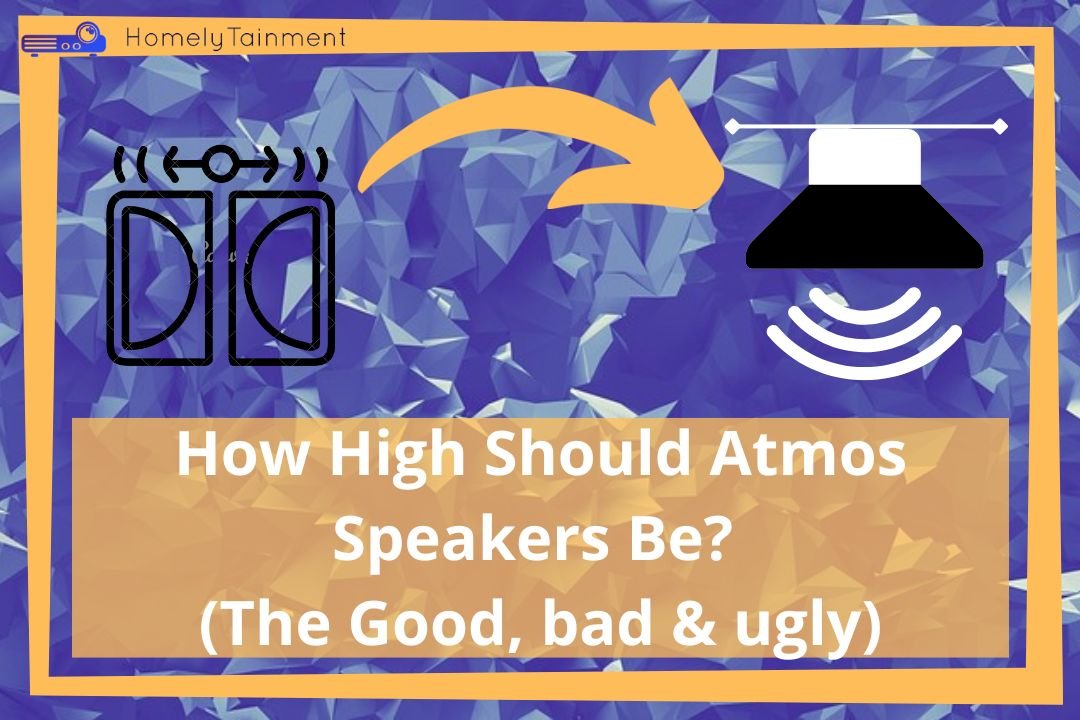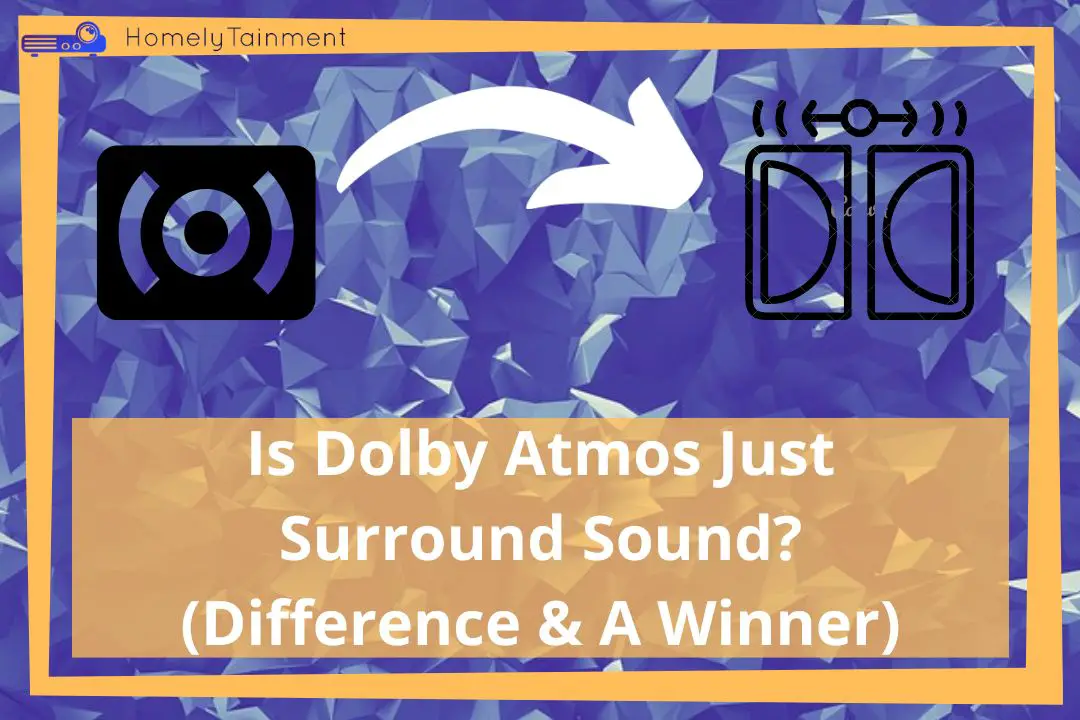
Homelytainment earn commissions (at no additional cost to you) if you purchase products from retailers after clicking on a link from our site.
The Dolby Atmos is the most tossed word by home theater equipment manufacturers. It is not only famous among manufacturers but also consumers. Almost every home theater owner either has it or wants to upgrade to Dolby Atmos.
Some are fortunate enough to start their home theater journey with the Atmos setup. But newbies are confused about the equipment they will need to have the best Atmos experience.
Getting the Atmos experience in your home is not difficult. The process is a little lengthy and needs a good explanation, but don’t worry it will not puzzle your mind. This guide at the end will clear your mind, and you will know what you need to get started.
Don’t forget to download the checklist at the bottom of this article. You can print this checklist and use it during the shopping or installation of the Dolby Atmos setup.
By searching what is needed for the Dolby Setup. I am pretty sure you already know what Dolby Atmos is. That’s why I will jump straight to the explanation of the equipment required for it.
I have linked a few more articles to this guide because this topic needs proper research of a few hours. After that, you can make better decisions.
What is needed for Dolby Atmos? At A Glance:
- Atmos Encoded media such as DVD Discs + a Blu-ray player or online streaming services + a device
- Dolby Atmos enabled AV receiver or separates or Atmos Soundbar
- You will need a proper Atmos speakers installation
- You will need a proper Speakers calibration
- A high-Quality projector or TV screen will be needed
- Use High-Quality HDMI cables that have at least 48 Gbps speed
- Use High-quality cables for the speakers’ connectivity with suitable thickness
Dolby Atmos encoded media such as DVD Discs or online streaming service
The first thing you need is content that is encoded in Dolby Atmos. You can get a DVD disc for any content that is in Atmos.
In many movies, the Atmos version comes with the 4K, but a few movies can have it in its Blu-ray format too.
Not every Atmos-labeled movie is right for you to buy. The Atmos should be encoded precisely and properly. After that, you can feel the Atmos effects.
But make sure the movie has a lot of overhead effects in it. Because Atmos is responsible a lot of the time for the overhead effects. The Atmos doesn’t deal only with the overhead effects, but its object-based audio. It is responsible both for surround sound and overhead effects. But without overhead effects, the Atmos is not Atmos.
You can search for your favorite movie in the Dolby directory, and you will know whether it is encoded in Atmos or not.
If you don’t want to buy DVD CDs for each of your favorite movies and also spend money on a DVD player, then you can subscribe to online streaming services such as Amazon Prime, Netflix, or VUDU. These streaming services have plenty of Atmos content, and they charge an affordable amount per month.
You will have to get a Blu-ray 4K player that supports HDR or Dolby Vision. You will need it if you don’t want to stream the content and play it from discs.
But for streaming, many modern projectors and TV interfaces provide the access to these streaming services. If your TV doesn’t provide then you will have to get a streaming device such as Roku or Amazon Fire Stick.
You can find out which audio and video streaming services provide Dolby Atmos content from my guide. I have gathered all the famous streaming services in this guide.
Dolby Atmos enabled AV receiver or separates or Atmos Soundbar
This headline might be hard for you to digest, but let me break it into two pieces for you.
Atmos AV Receiver or Separates
You will need a Receiver that can decode the Atmos properly. The AV receiver is for the newbies and for the pro guys the separate is the option.
In the separates, you get Preamp, amplifier, and audio/video process separately but in the AV receiver they are all included in one piece.
The AV receiver is the brain of the system. From here the theater system runs all the equipment of the system.
The receiver will encode the Atmos content on the media and will send its signals to the speakers. In this way, you will feel the object-based audio.
Dolby Atmos Soundbar
This is a bar that contains built-in speakers in it. Few speakers are for the front and surround speaker representation, and few are for the Atmos effects in it.
You don’t need to deal with the setup hustle of the speakers and receiver here. It is simple and just a plug-and-play system.
Final verdict: Which is better: the soundbar or the receiver for Atmos?
The receiver with a complete Atmos speakers setup is far superior to the soundbar in sound quality that you can’t even compare them. Also, their Atmos is real and the soundbar’s Atmos is just a simulation of the Atmos.
But the soundbar is a winner when it comes to convenience. You can know more about their differences in my this guide. Speakers vs soundbar: which is better? I have compared them to more than 7 features.
You will need a proper Atmos speakers installation
Before installation, you will have to pick the best type of speaker for this application.
There are a few types of Atmos speakers, and only one type is the winner. You can get height elevated speakers, in-ceiling speakers, or up-firing speakers for this application.
But the in-ceiling speakers are the ones that provide the best of the best Atmos experience. There is a reason behind it, but this guide will become more lengthy. I have compared them all in another guide. Are Atmos Speakers worth it? You will know which speakers are worth it and which are trash.
After that, you have selected the best speakers. Now you need each speaker to be installed in Dolby recommended angles to have the best and perfect Atmos experience. These angles are very important because the engineers in the Dolby Lab work hard on them.
Along with the angles, you will also know about the setup’s best practices.
You will need a proper Speakers calibration
After you have installed the speakers. Now, you need to calibrate them well. You will get an Audyssey mic or similar technology with almost every modern AV receiver. They will also provide you with instructions on how to use their calibration mic and calibrate the speakers.
You will have to place the mic where you will sit to watch the content. The receiver will play tonnes from each speaker and will calibrate the speakers for your seating area.
But if you want to calibrate the speakers by yourself. Then you need to manually calibrate each speaker. For this, you need each speaker in the system to hit you with 75dB sound in your seating area.
You will have to hold the SPL meter in your hand and play tones by each speaker and check what value you are getting for your seating area. Make sure that is 75dB for each speaker. But if you can’t get 75db at your seating area, then change the dB level of that speaker in your receiver sound setting menu. Keep on changing unless you get the 75 dB at your seating area.
You can get the best and most affordable SPL meter by reading my this review guide. Best sound pressure level meter for home theater? I have reviewed the top 3.
A high-Quality projector or TV screen will be needed
I am talking about the display source at the end of the equipment because the Atmos is 80% audio and 20% video.
Atmos doesn’t deal with video of the content, but I am saying 20% because you need something to see on the screen.
Because your brain should connect the audio sound in the room to the video content on the screen.
If you are confused about whether to choose a projector or TV. You can read my this guide: TV Vs Projector. What to choose for home theater? There are features in which the projector is good and in others, the TV is the winner. You should get a display source whose features are aligned with your interest and theater room environment.
Use High-Quality HDMI cables that have at least 48 Gbps Bandwidth
You will need a high-quality HDMI cable that has at least 48Gbs of bandwidth capability. Because this much bandwidth can actually transfer the Dolby Atmos signals. Not every HDMI cable has this bandwidth.
Don’t worry, they are not expensive. They will cost from $10-20. Don’t fall for the expensive gold-plated HDMI cables and blah, blah versions, and gimmicks. Read my this guide to know about cheap vs expensive HDMI cables. I have helpful tips for you to choose the best and cheap HDMI cable for yourself.
Use High-quality cables for the speakers’ connectivity with suitable thickness
The lower the gauge of the wire, the thicker it will be. The thicker it is, the less friction there will be. As a result, the signals will be clean and will transfer without loss in the data.
That’s why you need to choose a thicker wire for the speakers’ connectivity. The lower the gauge, the better the wire. But here the length and the ohm value of the speakers come into play.
As a general rule of thumb, you need a 16 gauge wire for 6-ohm speakers at a 45-50ft distance. This was a general rule of thumb, read a short chart of values in my this guide. What gauge wire to choose for home theater speakers? You can download a printable form of that chart from the bottom of the article.
Along with these wires, you need an RCA cable that can connect the subwoofer to your AV receiver.
What Is Needed For Dolby Atmos? (Downloadable Checklist)

FAQs
Can any speakers be used for Dolby Atmos?
Any 2-way nature speaker can be used for Dolby Atmos. You just have to install it in the ceiling and direct the Atmos signals to them. Your in-ceiling speakers will now act like Atmos speakers.
There is no specific composition of a speaker that turns it into an Atmos speaker. You just have to place it upright on another speaker or install it in the ceiling, and you are good to go.
How many speakers are needed for Dolby Atmos?
You need at least 4 speakers in the ceiling for a basic Dolby Atmos experience. Just two speakers are not enough because they can’t transition the audio from front to back of the audience. That’s why 4 speakers are recommended.
These 4 speakers are for one or two rows in the theater room.
Do you need 4K for Dolby Atmos?
You don’t need to have 4K for the Atmos. Many movies have Dolby Atmos audio on Blu-ray. In the future, they will have it in 8K or more.
The 4K has nothing to do with the Dolby Atmos. You can have Dolby Atmos in Blu-ray or 8K content too.
Helpful Resources For The FAQs To Read More
- This was my opinion, read more from this Audioholic Article. (Resource for the first answer)
- But if you want to calculate an exact number of speakers for more rows of the audience. Read my this guide. How many ceiling speakers do you need? (Resource for the Second answer)




